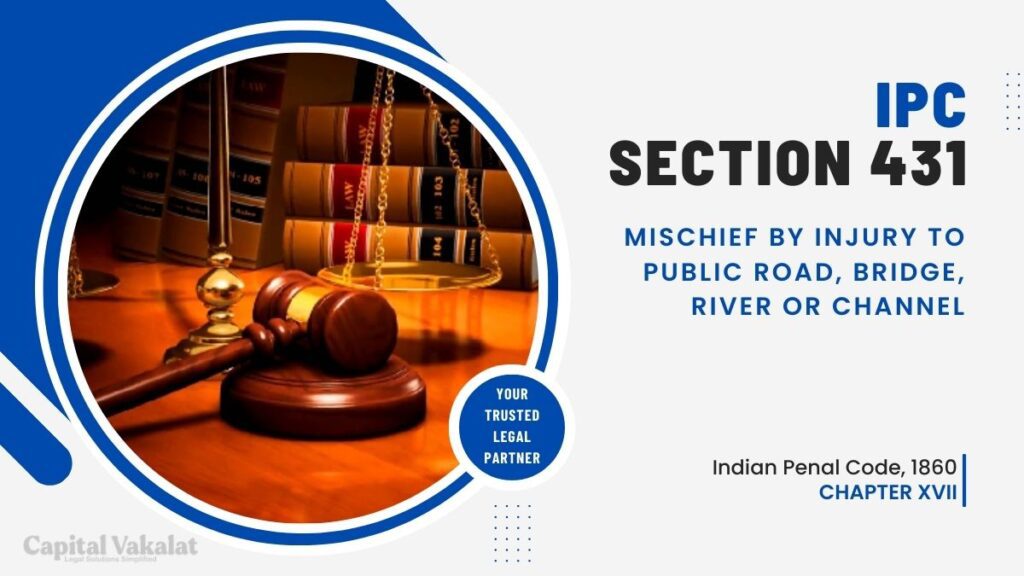Public infrastructure forms the backbone of any society, providing the essential framework for daily life. In this context, Section 431 of the Indian Penal Code (IPC) plays a crucial role in safeguarding public roads, bridges, rivers, and channels from acts of mischief. Let’s delve into the intricacies of this legal provision and explore its implications on societal well-being.

Section 431 IPC addresses offenses related to the willful injury or damage to public property, specifically focusing on public roads, bridges, rivers, and channels. The rationale behind this legal provision is rooted in the need to preserve and protect infrastructure that serves the greater community.
Understanding Mischief in Legal Terms
Mischief, as defined in legal terms, involves the intentional destruction or damage to property. In the context of Section 431 IPC, mischief extends to acts that harm public infrastructure, affecting the broader community. Offenders can face severe legal consequences for engaging in such activities.
Scope of Section 431 IPC
Public Road, Bridge, River, or Channel Defined
To comprehend the scope of Section 431 IPC, it’s essential to understand what constitutes a public road, bridge, river, or channel. The legal definition of these entities establishes the boundaries within which the offense can be committed.
Types of Damage Covered Under This Section
The section encompasses various forms of damage, ranging from minor defacement to substantial destruction. Whether it’s graffiti on a public wall or the deliberate destruction of a bridge, Section 431 IPC provides a comprehensive framework for addressing these offenses.
Punishments and Penalties
Violations under Section 431 IPC carry significant legal repercussions. The severity of punishments is often determined by the extent of damage caused. Offenders may face fines, imprisonment, or both, depending on the nature and gravity of the offense.
Notable Cases and Precedents
Examining past legal cases involving mischief to public infrastructure sheds light on the application and interpretation of Section 431 IPC. Notable cases and their outcomes provide insights into the judiciary’s stance on such offenses and their consequences.
The Impact on Society
Beyond legal consequences, acts of mischief to public infrastructure have far-reaching consequences for society. From economic ramifications to compromised safety, the impact underscores the need for stringent measures to prevent and address such offenses.
Preventive Measures
Role of Public Awareness
Creating awareness among the public about the implications of damaging public infrastructure is crucial. Educational campaigns can serve as deterrents, discouraging individuals from engaging in destructive behavior.
Legal Measures to Deter Offenders
Enforcing Section 431 IPC requires a robust legal framework. Strengthening penalties, improving surveillance, and streamlining legal processes contribute to creating an environment where potential offenders think twice before committing acts of mischief.
Collaborative Efforts
Protecting public infrastructure necessitates collaboration between law enforcement, communities, and government bodies. Establishing partnerships and implementing strategies that involve all stakeholders contribute to more effective protection measures.
Challenges and Solutions
Identifying Enforcement Challenges
Enforcing Section 431 IPC faces challenges such as identifying offenders, collecting evidence, and ensuring swift legal action. Addressing these challenges is pivotal for the effective implementation of the legal provision.
Proposed Solutions for an Effective Legal Framework
Streamlining legal procedures, leveraging technology for surveillance, and fostering community engagement are among the proposed solutions to strengthen Section 431 IPC. A comprehensive approach is essential for mitigating the challenges associated with enforcing this provision.
Conclusion
In conclusion, Section 431 IPC serves as a vital tool in preserving the integrity of public infrastructure. Understanding its implications, enforcing stringent penalties, and fostering collaborative efforts are crucial steps in ensuring the protection of our communal resources.
Frequently Asked Questions
What are the legal consequences of violating Section 431 IPC?
Violations under Section 431 IPC can result in fines, imprisonment, or both, with the severity of penalties determined by the extent of damage caused.
How can public awareness contribute to preventing offenses under Section 431 IPC?
Public awareness campaigns play a crucial role in deterring potential offenders by highlighting the consequences of damaging public infrastructure.
What collaborative efforts are necessary to protect public infrastructure?
Collaboration between law enforcement, communities, and government bodies is essential for effective protection measures against mischief to public infrastructure.
What challenges does the enforcement of Section 431 IPC face, and how can they be addressed?
Challenges in enforcement include identifying offenders and collecting evidence. Streamlining legal procedures, leveraging technology, and community engagement are proposed solutions to overcome these challenges.